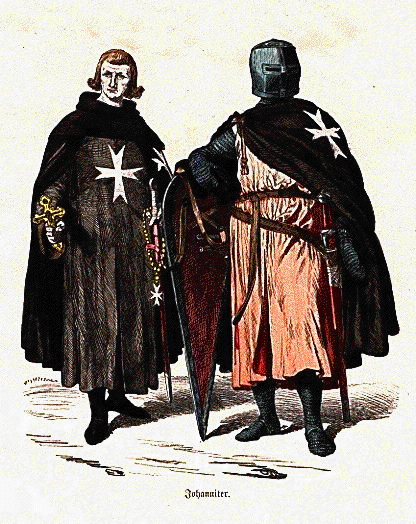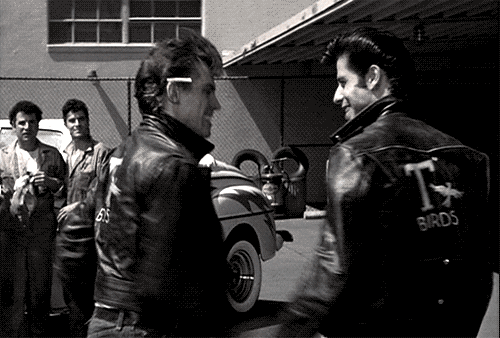THE VATICANS NEW WORLD ORDER – THE KNIGHTS OF MALTA – a well-researched history that may shed light on Masonry. At least it is a jumping off point to understanding. . . ~J
Posted on June 17, 2013 by Jean
Thursday, 1 November 2012
Source: VaticanNewWorldOrderBlogspot
The Roman Catholic Church uses military-like orders or societies to carry out their aims and protect the Church. Using these societies as a secret army to do the Church’s bidding protects it from scrutiny and bad press. For example, in the Middle Ages, the Knights Templar was an order that fought in the crusades on behalf of the Papacy. Templar Knights were giventhe ability to ignore many laws, taxes, and authorities, but had to obey the Pope.i

The regalia of the Knights Templars. Note theMaltese crosses.
Enlarge picture
View picture gallery
Although we don’t see the Knights Templar in their original form, there are many new versions of the Order, such as theKnights of Malta, Freemasons, and the various Orders of knights in Britain. European and North American political leaders are often members of these Orders.
If the Order is subservient to the Pope alone, and the British Queen and American President are members of the Order, who really rules the Western world?
The Knights of Malta

A Knight of Malta depictedin the Catholic Encyclopedia.
Enlarge picture
View picture gallery

Queen Elizabeth II inher Maltese robe. Elizabeth is theSovereign Head of theOrder… read more.
Enlarge picture
View picture gallery
One Order of particular interest is the Knights of Malta. According to the Catholic Encyclopedia, the Order of the Knights of Malta is, “The most important of all the military orders, both for the extent of its area and for its duration. It is said to have existed before the Crusades and is not extinct at the present time.”ii
The Knights of Malta wore similar costumes to the Knights Templar before them. The stylized cross we see on their uniforms is known today as a Maltese cross.

Pope Benedict is greeted by the former Grand Master of the Order of Malta, Prince… read more.
Enlarge picture
View picture gallery
The Maltese cross is a common feature of the Pope’s garments, reminding us that he is the head of these Orders.
A Protestant branch of the Knights of Malta is the Order of St. John of Jerusalem. Queen Elizabeth II is the Sovereign Head of the Order of St. John,iii as we can see from her costume in the photograph.
The Queen’s participation in this Order, which brings with it required obedience to the Pope, is an example of how King John’s ancient concession of the crown to the Papacy is still in effect today.
America
The United States is also under the rule of the Papacy. Most American presidents have been involved in Freemasonry, which is an outwardly Protestant secret society that is actually controlled by Catholic Jesuits.
Presidents and other American leaders also have strong blood connections to British royalty, and many have been initiatedinto Knighthood in the Order of the Bath under the Queen. American leaders give their allegiance to the Queen, and theQueen is subservient to the Pope, which is just another way that the Papacy controls America.
The Order of the Bath, the Knights of Malta, and the Knights Templar are all the same. Behind the elaborate pomp of these orders sits the same power—the same people calling the shots.



Posted on June 17, 2013 by Jean
Thursday, 1 November 2012
Source: VaticanNewWorldOrderBlogspot
The Roman Catholic Church uses military-like orders or societies to carry out their aims and protect the Church. Using these societies as a secret army to do the Church’s bidding protects it from scrutiny and bad press. For example, in the Middle Ages, the Knights Templar was an order that fought in the crusades on behalf of the Papacy. Templar Knights were giventhe ability to ignore many laws, taxes, and authorities, but had to obey the Pope.i

The regalia of the Knights Templars. Note theMaltese crosses.
Enlarge picture
View picture gallery
Although we don’t see the Knights Templar in their original form, there are many new versions of the Order, such as theKnights of Malta, Freemasons, and the various Orders of knights in Britain. European and North American political leaders are often members of these Orders.
If the Order is subservient to the Pope alone, and the British Queen and American President are members of the Order, who really rules the Western world?
The Knights of Malta

A Knight of Malta depictedin the Catholic Encyclopedia.
Enlarge picture
View picture gallery

Queen Elizabeth II inher Maltese robe. Elizabeth is theSovereign Head of theOrder… read more.
Enlarge picture
View picture gallery
One Order of particular interest is the Knights of Malta. According to the Catholic Encyclopedia, the Order of the Knights of Malta is, “The most important of all the military orders, both for the extent of its area and for its duration. It is said to have existed before the Crusades and is not extinct at the present time.”ii
The Knights of Malta wore similar costumes to the Knights Templar before them. The stylized cross we see on their uniforms is known today as a Maltese cross.

Pope Benedict is greeted by the former Grand Master of the Order of Malta, Prince… read more.
Enlarge picture
View picture gallery
The Maltese cross is a common feature of the Pope’s garments, reminding us that he is the head of these Orders.
A Protestant branch of the Knights of Malta is the Order of St. John of Jerusalem. Queen Elizabeth II is the Sovereign Head of the Order of St. John,iii as we can see from her costume in the photograph.
The Queen’s participation in this Order, which brings with it required obedience to the Pope, is an example of how King John’s ancient concession of the crown to the Papacy is still in effect today.
America
The United States is also under the rule of the Papacy. Most American presidents have been involved in Freemasonry, which is an outwardly Protestant secret society that is actually controlled by Catholic Jesuits.
Presidents and other American leaders also have strong blood connections to British royalty, and many have been initiatedinto Knighthood in the Order of the Bath under the Queen. American leaders give their allegiance to the Queen, and theQueen is subservient to the Pope, which is just another way that the Papacy controls America.
The Order of the Bath, the Knights of Malta, and the Knights Templar are all the same. Behind the elaborate pomp of these orders sits the same power—the same people calling the shots.

MASONIC KNIGHTS OF MALTA, INTRODUCTION
As we progress through the degrees, many titles, badges and passwords (signs of recognition) are bestowed on us. Many ofthese titles and the like stem from ancient times, and all have their own history to tell. However, it is very often the case, that we do not learn nor understand what this history is. One of the example is the Knights of Malta, as given in the degree of that name in the Commandery.
BACKGROUND
The Knights of Malta are famous for their heroic stance in the battle defending Malta from Salyman II in 1565, but there is much more to their history.
The Knights of Malta were not always called by that name. Indeed, looking at the history of this order, we find three distinct periods:
- The Hospitaller of St. John of Jerusalem From unknown – 1309
- The Knights of Rhodes From 1309-1522
- The Knights of Malta From 1530 – present
THE FIRST PERIOD (? – 1309)
The exact origin of the Order is not known, but it is generally accepted that merchants from Amalfi obtained permission from the Caliph of Egypt to build a hospital in Jerusalem to aid and assist visiting pilgrims. However, this organization became a legitimate and separate Order when Gerard (whose last name is never mentioned and who was later beautified) erected his first hospital in around 1080, although it was not officially started until 1113, when Pope Pascal II acknowledgedthe group as an order. This is known, as a the Bull of Pascal, dated February 3, 1113, and read as follows:“His Venerable Son Gerard, Founder and Director of the Hospital of Jerusalem and his legitimate successors in perpetuity”, continues “….you have asked us that the hospital you have founded in the city of Jerusalem, near the church of Saint Johnthe Baptist, should be fortified by Authority of the Holy See and strengthened by the protection of the Apostle Saint Peter ……..we accede to your demands with paternal clemency and we place by authority of this present decree, this House of God, this Hospital, under obedience to the Apostolic See and the protection of Saint Peter …..given that you are actually administrator and director of this hospital we wish that, at your death, no-one may be put at its head by ruse or violence and that the professed brothers may proceed to this election following the inspiration of God……. We confirm in perpetuity, both for you and your successors … all the advantages, honorifics and possessions that it presently holds in Asia and Europe and that it may acquire in the future, exempting them from all tithes.”
The main objective of the order was to serve and care for the sick and injured pilgrims visiting the Holy Land from Europe, of which there were numerous ones even before the Crusades. The leader of the order was originally called “The Master ofthe Hospital”, but from 1267 the name was changed to Grand Master, who served for life. The Order grew as many of its patients donated land, both in Europe and in the Holy Land as gratitude for their services. As a matter of fact, early documents mentioning such donations, do not mention the sick, only the poor and strangers. The Order was also only concerned with religious conducts, and at first never mentioned anything about knights. Over time however, as thenumber of pilgrims increased, so did the need for their protection. For this reason, knights were recruited from theCrusaders to serve as their protection. This is said to have been the beginning of the military side of the Order. The order’s members were divided into three “classes”,
The military brothers
The infirmary brothers
The Chaplain brothers
The Military brothers consisted of knights recruited from the Crusades, and were called “Heavy Cavalry”. They were commanded by a “Marshal”. Lower-ranking men were recruited from amongst the locals, and were called “Turcopeles”. Those assigned to oversee the Turcopeles were called Turcopiliers. This title is still used in the Scottish Rite Council of Kadosh. The first mention of the military aspects of the Order are found in documents dating from about 1200, and identified two types of knights. The first were knights serving the order for a short period of time, and were called secular knights. The second were knights who vowed permanent allegiance to the order, and were called professed knights. As theorder grew, they became rivals with the pure military order, the Knight Templars. To differentiate themselves from theTemplars, the Hospitallers wore a black cape with a white cross, while the Templars wore white capes with a red cross. Theorder later enjoyed vast privileges like the Templars, of being independent in spiritual and temporal authority (except from Rome), the right to have their own chapels and cemeteries, and their own clergy.
THE SECOND PERIOD (1309-1522)
THE THIRD PERIOD (1530 – PRESENT)
Despite seven Crusades, Jerusalem fell to Saladin in 1187 and the Order lost all of its possessions except those in thePrincipality of Tripoli and Cyprus. They settled in Acre, which also fell to the Turks in 1291, whereupon they fled to Cyprus.The Knight Hospitallers settled in the island of Rhodes in 1309. However, on this island there were few, if any, pilgrims to protect, and from this period on the Order became more militaristic. Another transformation took place; although theKnights were trained and experienced in land battles, in Rhodes the deciding factor became sea battles. In addition, with its isolation, the island and the Grand Master of the Order gained much independent power, equal to that of a small principality. Then, the Ottoman Turks rose in power, and in 1480 Mahomet II attacked the island but was repulsed. Then in 1522, Salyman II attacked Rhodes with an armada of 400 ships and an army said to have numbered between 140,000 and 200,000 men, clearly outnumbering the 7,000 knights. The knights held out for six months, but having no more supplies, surrendered on December 22, 1522. Salyman II, respecting their bravery, decided to spare their lives, and even made ships available to carry the remaining Knights to Europe.
Upon returning to Europe, the Order sought a new base, but the times had changed, and no monarchy was willing to listen.Then, in 1530, the Order asked Emperor Charles V of Spain to give them Malta, which he did.

Grand Master Phillipe Villiers de L’Isle Adam (24 March 1530 – 21 August 1534)
shown taking the silver key to the city from the Captain of the Rod in Malta, October 26, 1530
shown taking the silver key to the city from the Captain of the Rod in Malta, October 26, 1530
From this period, the knights wore the famous Maltese Cross. It is an eight-pointed cross, the eight points representing theeight obligations and aspirations which are:
 |
Live in Truth |
On May 18, 1565, Salyman II, regretting his previous mercy, attacked Malta with, it is said, 38,000 troops and 138 galleys for four months against 500 knights and 5,000 soldiers which were dispersed in two strongholds. The Turks first destroyed theold city, then focused their attention to St. Elmo, a fort in which some knights were holding out. It is said over 6,000 cannonballs were fired into the fort and the fort capitulated on June 23rd after losing half its force. The survivors, 100 knights and 500 soldiers, were all executed, their bodies floated in the harbor on wooden crosses to intimidate theremaining knights holding out. The remaining 300 knights held out across the harbor at Birgu and Senglea. Desperate pleas to Spain were finally answered, when a large army arrived on the island, and the Turks retreated.
Their main rival defeated, ironically, also caused the decline of the order. Having no one major power to defeat, support forthe Order declined. This, combined with the increased difficulty of recruiting new members, many of them having converted to the Protestant and teaching of Martin Luther, caused the Order to decline.
The Knights of Malta, as they were known, stayed in Malta until their Grand Master, Count von Hompesch, surrendered to Napoleon’s army on June 12, 1798 without a fight. Many of the knights were French, and had no intention to fight againsttheir co-religious, countrymen. The knights left Malta for Italy, and constantly tried to recover their island of Malta. In 1802,the war between France and Great Britain ended by the Treaty of Amiens, in which it specifically mentioned that Malta should be restored to the knights. However, before it could be implemented, France and Great Britain were at war again.The Order lost all hope of retaining Malta with the Treaty of Paris in 1814, in which it was stipulated that Malta would be British. Sweden offered the Order the island of Gottland in the Baltic, but this offer was rejected as it would have meant giving up the claims to Malta.
Since this time, the Order’s headquarters is located in Rome. Czar Paul of Russia gave the Order considerable land, and in return was elected Grand Master in 1798, but the election was not recognized by the Pope, and decided that he would appoint a Grand Master from that time onwards. The Pope did not name a Grand Master from 1805 to 1879, after which Pope Leo XIII re-established the position.
From this time, the military side of the Order was lost, and it once again became a pure charitable organization. It’s first major action came in the Crimean War. The Order, in 1994, was given the same status as the Red Cross, being an Observer Member of The United Nations (See Appendix II). It currently lists about 11,000 members.

Queen Elizabeth II in the robes of Sovereign Head of the Order in Great Britain
APPENDIX I: LIST OF KNOWN GRAND MASTERS OF THE ORDER (YEAR OF LAST REIGN):
1) Gerard, 1109 – 1120
2) Raymond of Provence (aka Raymond du Puy), – 1160
3) ?
4) ?
5) ?
6) Gosbert, – 1177
7) Roger de Moulins, – 1187
8)?
9) Alfonso of Portugal, – 1200
10 – 16) ?
17) Hugh of Ravel, – 1270
18-42) ?
43) Pierre d’Aubusson, – 1480
44) Phillipe Villiers de l’Isle-Adam – France, – 1530
45) Pietro del Ponte – Italy, – 1534
46) Didier de Saint-Jaille – France, – 1535
47) Juan d’Omedes – Aragon, – 1536
48) Claude de la Sengle – France, – 1553
49) Jean de la Valette-Parisot – Provence, – 1557
50) Pierino del Monte San Savino – Italy, – 1568
51) Jean Levesque de la Caissiere – Auvergne, – 1572
52) Hughes Loubenx de Verdalle – Provence, – 1582
53) Martin Garzes – Aragon, – 1595
54) Alof de Wignacourt – France, – 1601
55) Louis Mendes de Vasconcellos Castille Leon – Portugal, – 1622
56) Antoine de Paule – Provence, – 1623
57) Jean-Paul de Lascaris-Castellar – Provence, – 1636
58) Martin de Redin – Aragon, – 1657
59) Annett de Clermont-Gessan – Auvergne, – 1660
60) Raphael Cotoner – Aragon, – 1660
61) Nicolas Cotoner – Aragon, – 1663
62) Gregorio Carafa – Italy, – 1680
63) Adrien de Wignacourt – France, – 1690
64) Raymond Perellos y Roccaful – Aragon, – 1697
65) Marc’Antoinio Zondadari – Italy, – 1720
66) Antoine Manoel de Vilhena Castille, Leon – Portugal, – 1722
67) Raymond Despuig – Aragon, – 1736
68) Emmanuel Pinto de Fonseca – Castille, Leon – Portugal, – 1741
69) Franciscus Ximenes de Texada – Aragon, – 1773
70) Emmanuel Marie de Rohan-Polduc – France, – 1775
71) Ferdinand von Hompesch – Germany, – 1797
>
72) Geschi di Sancta Croce, Austria, – 1905
73)Giovanni-Battusta Ceschi – Austria, – 1905
74) Galeazzo von Thun un Hohenstein – Austria, – 1931
75) Ludovico Chigi Albani della Rovere, – 1951
76) Angelo de Mojana di Cologna, – 1962
77) Andrew Willoughby Ninian Bertie 1988 – present
APPENDIX II: OBSERVER MEMBERS OF THE UNITED NATIONS
The following is a list of entities and intergovernmental organizations having received a standing invitation by The United Nations to participate as observers in the sessions and the work of the General Assembly and maintaining permanent offices:
Palestine (formerly the PLO)
Asian-African Legal Consultative Committee
Caribbean Community
Commonwealth Secretariat
European Community
International Organization for Migration
International Organization of la Francophonie
International Seabed Authority
International Tribunal for the Law of the Sea
League of Arab States
Organization of African Unity
Organization of the Islamic Conference
International Committee of the Red Cross
 International Federation of Red Cross and Red Crescent
International Federation of Red Cross and Red CrescentPapal Politics
When we examine the symbolism of the English Orders, we see some shocking messages. Why does everyone bow before thePope – whether they are a religious or a political leader? Why didthe Queen visit the pope dressed in black? Why do so many visitthe pope dressed in black? And why are political leaders such as Ronald Reagan and George Bush knighted? What service did they do? When we study the symbolism there is much that can be gleaned. The Queen, the Knights, the Orders are all subject to thePope. England has long ago lost its independent state and is now subject to the Papacy, but most don’t know it. Can there be a deeper meaning to the rituals and symbolism?

In 1982 Pope John Paul II visited the UK, kissing the ground at Gatwick airport as a show of authority. BBC News tells us that, “In the afternoon, a crowd of 80,000 gathered for mass at Wembley stadium in what was billed as the first ofthe Pope’s ‘outdoor spectaculars.’ They sang ‘He’s got the whole world in his hands’ and clapped their hands as he arrived in his ‘Popemobile.’”
Source: BBC News (February 2, 2005).






 Sat Mar 23, 2024 11:33 pm by globalturbo
Sat Mar 23, 2024 11:33 pm by globalturbo





























































































































 science of "hydro-creationism."
science of "hydro-creationism."

